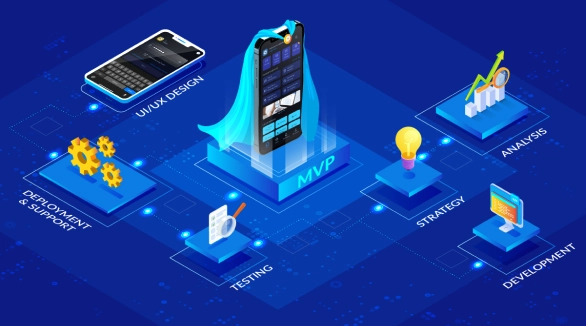MVP Development Process for Banks & Financial Services
Here is how our software development team deliver exceptional MVP software for the BFSI sector
By leveraging proven methodology, we provide full-cycle MVP development services with high quality to validate your product-market fit quickly

In the fast-evolving BFSI industry, launching a Minimum Viable Product (MVP) allows you to test your financial service or product idea with essential features that meet the core needs of early adopters. As an MVP professional financial consultancy company, we ensure that your financial innovations are strategically tested and refined for market viability.
Our MVP development process focuses on delivering a streamlined version of your product to validate market fit and gather valuable user feedback. This approach helps you address customer pain points effectively and cost-efficiently while paving the way for scalable and successful full-scale solutions.
We provide end-to-end MVP solutions, guiding you from concept to market-ready product. Our process includes market research, design, development, and testing, ensuring your MVP meets user needs and business goals efficiently. Get to market faster with a cost-effective, scalable foundation for future growth.
Start with essential features like account balance checks, basic money transfers, and bill payments. As you validate the concept, you can expand into more advanced functionalities like investment services or loan applications.
Develop a user-friendly platform for buying and selling financial instruments, complete with integration of online payment gateways for seamless transactions.
Create a basic online form to provide quick insurance quotes based on minimal input, testing the demand for a self-service insurance portal.
Launch a fundamental platform allowing users to lend and borrow small amounts, focusing on user verification and loan repayment tracking to validate your business model
Flexibly scale up the internal team as you grow and efficiently accelerate the development process. Our experts are proficient in diverse programming languages, tools, and frameworks to create exceptional products.
Security is paramount in the BFSI industry. We adhere to stringent security protocols and industry-recognized certifications, including PCI DSS and ISO/IEC 27001:2013, to protect your product and data rigorously.
Our advanced project management and cost control techniques ensure that your MVP is delivered on time and within budget. We help articulate your value proposition effectively while maintaining adherence to agreed timelines.
Here is how our software development team deliver exceptional MVP software for the BFSI sector
Begin with a strategic consultation and market analysis to validate your idea, leveraging data to ensure alignment with user needs. Prioritize features that offer the greatest ROI.
Create wireframes and intuitive UI/UX designs to visualize your concept. Gather user feedback with interactive prototypes to refine the design
Utilize agile development for iterative delivery of key features. Conduct continuous testing to ensure performance, security, and functionality.
Deploy your MVP with strategies to maximize reach and performance. Collect analytics and user feedback for iterative improvements and future planning.
The cost of developing an MVP in the BFSI sector depends on various factors, including the complexity of the project, the features required, and the specific development needs. Each project is unique, and the investment will vary based on the scope and tailored solutions necessary to meet your business objectives. For a detailed estimate, we recommend discussing your project requirements with our team.
Connect with us at KMS Solutions to create, at minimum, a viable product that drives your business forward.



Your information has been sent to KMS Solutions team. Our team will contact you shortly!
For direct contact, drop us a line here:

An MVP (Minimum Viable Product) is a simple, ready-to-launch version of a product that includes only the most essential elements (which define its value proposition). It is created with the intention of shortening the time to market, recruiting early adopters, and attaining product-market fit right away.
Initial feedback is expected after the MVP is released. Based on this feedback, the company will continue to repair bugs and add new features suggested by the early adopters.
The MVP method enables for the following:
Testing, designing, and delivering the final product are all made easier with MVP. MVP Development is an important part of web design and development. Many businesses fall into pitfalls when it comes to creating a Minimum Viable Product for a mobile or web app. As a result, it’s vital to grasp the key question: how should a Minimum Viable Product be created?
An MVP (Minimum Viable Product) is a basic version of a product with core features to test its viability in the market. For MVP financial services, it helps validate ideas quickly and cost-effectively.
By focusing on essential features, MVP development minimizes upfront costs and allows for early testing, reducing the risk of investing in unproven ideas.
The following are some of the advantages of creating an MVP:
Key features typically include core functionalities that address primary user needs, such as basic transactions, account management, and security features.
We follow industry standards and regulations, including PCI DSS and ISO/IEC 27001:2013, to ensure compliance and security throughout the development process.
The timeline varies based on complexity, but typically, an MVP can be developed within 3 to 6 months, including ideation, development, and initial testing phases.
KMS Solutions stands out as an exceptional MVP development company, offering a reliable partnership with deep experience in delivering MVPs for the financial services sector. Our extensive portfolio and numerous positive client reviews demonstrate our expertise. With a product-centric approach, KMS focuses on understanding customer needs, ensuring market success for your solution. Our flexible and well-structured team is perfectly suited to adapt to evolving business requirements, guaranteeing a seamless development process from concept to launch.